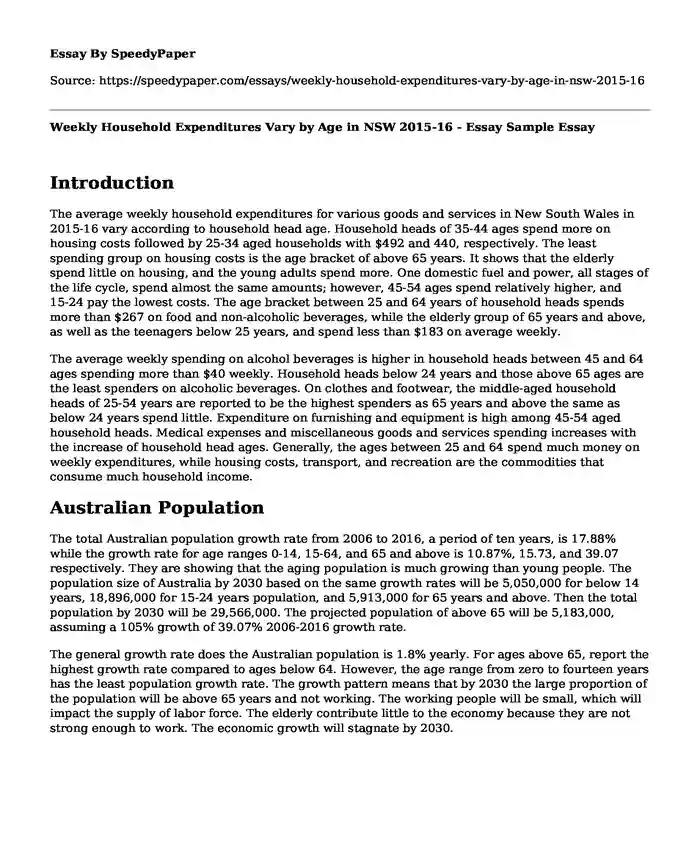
| Type of paper: | Essay |
| Categories: | Population Society |
| Pages: | 3 |
| Wordcount: | 568 words |
Introduction
The average weekly household expenditures for various goods and services in New South Wales in 2015-16 vary according to household head age. Household heads of 35-44 ages spend more on housing costs followed by 25-34 aged households with $492 and 440, respectively. The least spending group on housing costs is the age bracket of above 65 years. It shows that the elderly spend little on housing, and the young adults spend more. One domestic fuel and power, all stages of the life cycle, spend almost the same amounts; however, 45-54 ages spend relatively higher, and 15-24 pay the lowest costs. The age bracket between 25 and 64 years of household heads spends more than $267 on food and non-alcoholic beverages, while the elderly group of 65 years and above, as well as the teenagers below 25 years, and spend less than $183 on average weekly.
The average weekly spending on alcohol beverages is higher in household heads between 45 and 64 ages spending more than $40 weekly. Household heads below 24 years and those above 65 ages are the least spenders on alcoholic beverages. On clothes and footwear, the middle-aged household heads of 25-54 years are reported to be the highest spenders as 65 years and above the same as below 24 years spend little. Expenditure on furnishing and equipment is high among 45-54 aged household heads. Medical expenses and miscellaneous goods and services spending increases with the increase of household head ages. Generally, the ages between 25 and 64 spend much money on weekly expenditures, while housing costs, transport, and recreation are the commodities that consume much household income.
Australian Population
The total Australian population growth rate from 2006 to 2016, a period of ten years, is 17.88% while the growth rate for age ranges 0-14, 15-64, and 65 and above is 10.87%, 15.73, and 39.07 respectively. They are showing that the aging population is much growing than young people. The population size of Australia by 2030 based on the same growth rates will be 5,050,000 for below 14 years, 18,896,000 for 15-24 years population, and 5,913,000 for 65 years and above. Then the total population by 2030 will be 29,566,000. The projected population of above 65 will be 5,183,000, assuming a 105% growth of 39.07% 2006-2016 growth rate.
The general growth rate does the Australian population is 1.8% yearly. For ages above 65, report the highest growth rate compared to ages below 64. However, the age range from zero to fourteen years has the least population growth rate. The growth pattern means that by 2030 the large proportion of the population will be above 65 years and not working. The working people will be small, which will impact the supply of labor force. The elderly contribute little to the economy because they are not strong enough to work. The economic growth will stagnate by 2030.
The Labor Force in Australia in 2016
Of the total population in Australia in 2016, 49% are males, while 51% are females. Males occupy a large percentage of employed and working full-time with a 63% rate while the females have a standard 37% of the working and working full-time population. In employed part-time, 33% are males, and the females are 67%. Females are the most employed away employed and away from a percentage of 53%, and the males have 47%. The population looking for employment but full time is most men with a portion of 63%, while those looking for part-time work are mostly females with a 59% rate. Most females are not in the labor force compared to men with rates of 58% and 42%, respectively. The larger population in Australia below 15 years are majorly females with a percentage of 64% in comparison with males who are 36%.
Cite this page
Weekly Household Expenditures Vary by Age in NSW 2015-16 - Essay Sample. (2023, Sep 12). Retrieved from https://speedypaper.net/essays/weekly-household-expenditures-vary-by-age-in-nsw-2015-16
Request Removal
If you are the original author of this essay and no longer wish to have it published on the SpeedyPaper website, please click below to request its removal:
- Public Relation Analysis of Metro Trains: Dumb Ways to Die. Free Essay.
- Literary Essay Example: Disfigured Heritage in Kindred
- Free Essay. International Migration and Social Theory by Karen O'reilly
- Free Essay: Single Memorable Day
- Politics, Patient Protection, and Affordable Care Act Discussion - Paper Example
- Navigating Gender Roles: A Critical Analysis of Feminism, Partnership, and Motherhood in Contemporary Society
- Free Essay Example: Future of Feminism in the United States
Popular categories




